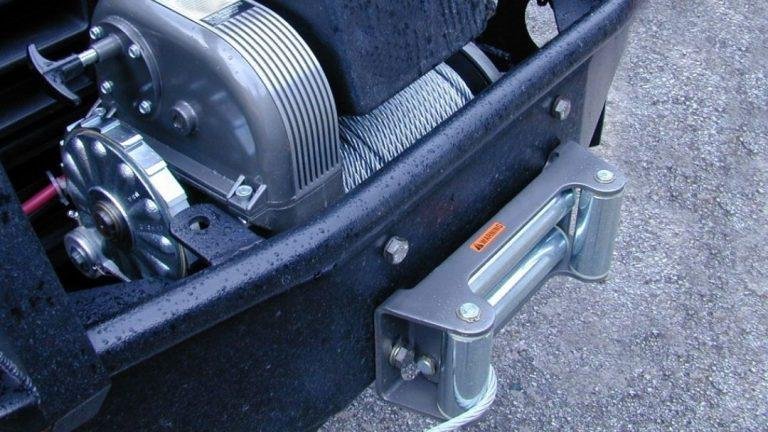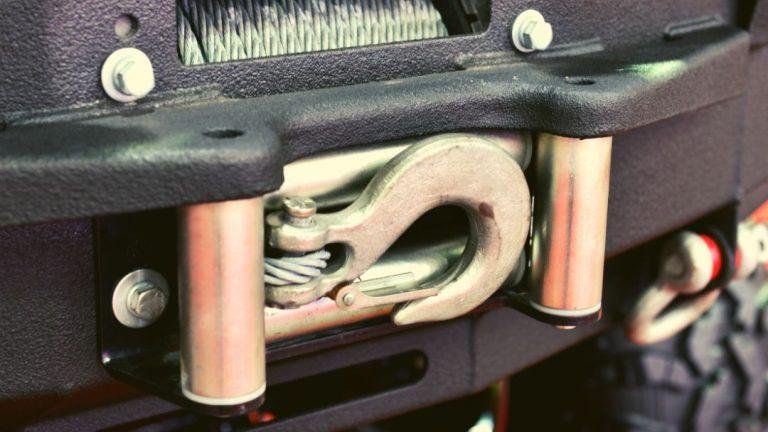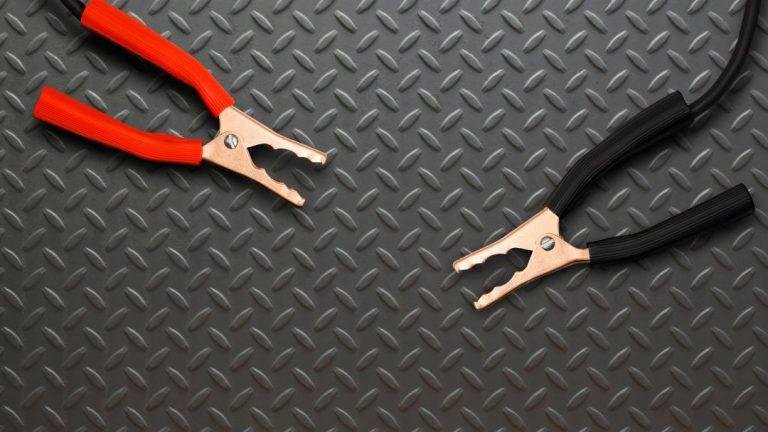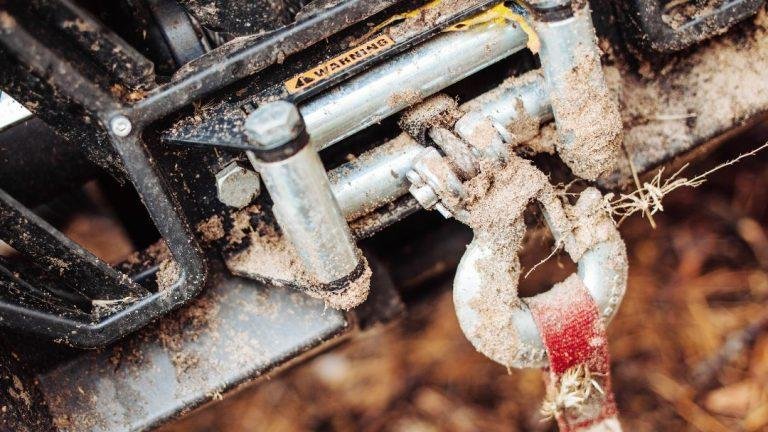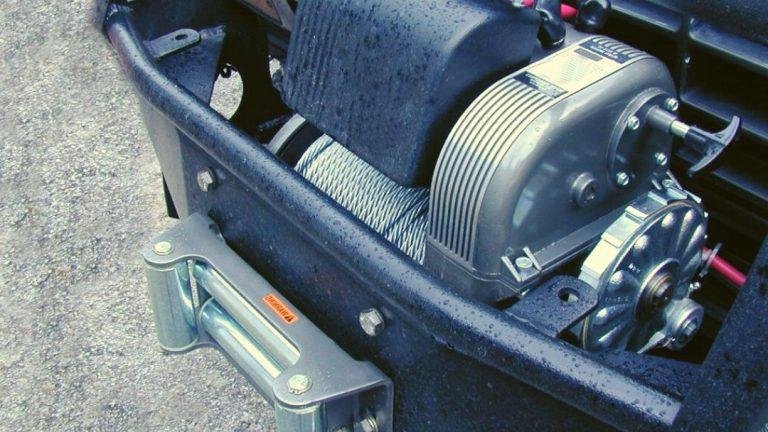To use a winch shackle, attach one end to the winch hook or anchor point, and the other end to the load you want to pull. Now, let’s delve deeper into how to use a winch shackle effectively.
When it comes to using a winch shackle, following a few simple steps can ensure safe and efficient operation. First, identify the desired anchor point or attach the winch hook to the load. Then, connect one end of the winch shackle to the winch hook or anchor point, and the other end to the load.
Once securely connected, engage the winch, maintaining tension on the line, and slowly pull the load. Always ensure proper alignment and secure attachment before beginning the pulling process. By adhering to these steps, you can effectively use a winch shackle in various lifting and recovery scenarios.
Understanding Winch Shackles
Understanding winch shackles is essential when it comes to using a winch safely and effectively. These powerful tools can be used to connect the winch to objects, providing a secure and reliable way to pull or lift heavy loads. By following proper techniques and guidelines, you can maximize the functionality of your winch shackle and ensure successful use in various situations.
What Is A Winch Shackle?
A winch shackle is a vital tool for off-road enthusiasts that provides a safe and effective means of connecting a winch line to an object, such as a tree or vehicle, during recovery operations. This powerful piece of equipment is designed to withstand extreme pulling forces, making it an essential component of any off-road recovery kit.
Different Types Of Winch Shackles
When it comes to winch shackles, there are various types available on the market, each with its unique features and benefits. Here are a few common types:
- Bow shackle: This type of shackle features a larger loop shape on one end and a smaller loop on the other. It is versatile and commonly used due to its superior strength and reliable performance.
- Screw pin shackle: Screw pin shackles have a threaded pin that screws into the shackle body, offering a secure and easy-to-use design. They are commonly used in non-load-bearing applications.
- Safety pin shackle: Safety pin shackles have a removable cotter pin or clip that secures the pin in place, minimizing the chances of accidental release. They are widely used in heavy-duty applications.
- Soft shackle: Made from high-strength synthetic rope, soft shackles are a lightweight and safe alternative to traditional steel shackles. They are highly flexible and offer excellent strength.
Choosing The Right Winch Shackle For Your Off-Road Needs
Selecting the appropriate winch shackle for your off-road adventures is crucial to ensure safe and efficient recoveries. Consider the following factors to make an informed choice:
- Strength: Choose a shackle with a safe working load limit (swl) that exceeds the weight of the vehicle you will be recovering. It’s essential to have a safety margin to account for unexpected forces.
- Material: Shackles are typically made from durable materials like stainless steel or forged alloy steel. Opt for high-quality shackles that are rated for heavy loads and designed to withstand harsh conditions.
- Size: Consider the size of the shackles based on the diameter of your winch cable or recovery rope. Ensure a proper fit to maximize strength and prevent unnecessary overloading.
- Ease of use: Look for shackles with user-friendly features like quick-release mechanisms or easy pin attachment. It’s important to have a shackle that can be safely and efficiently fastened during recovery operations.
- Versatility: If you participate in different off-road activities, a versatile shackle that can accommodate various applications and loads is beneficial.
Remember, the winch shackle you choose should be reliable, strong, and compatible with your specific off-road needs. Prioritize safety and quality to ensure successful recoveries and an enjoyable off-roading experience.
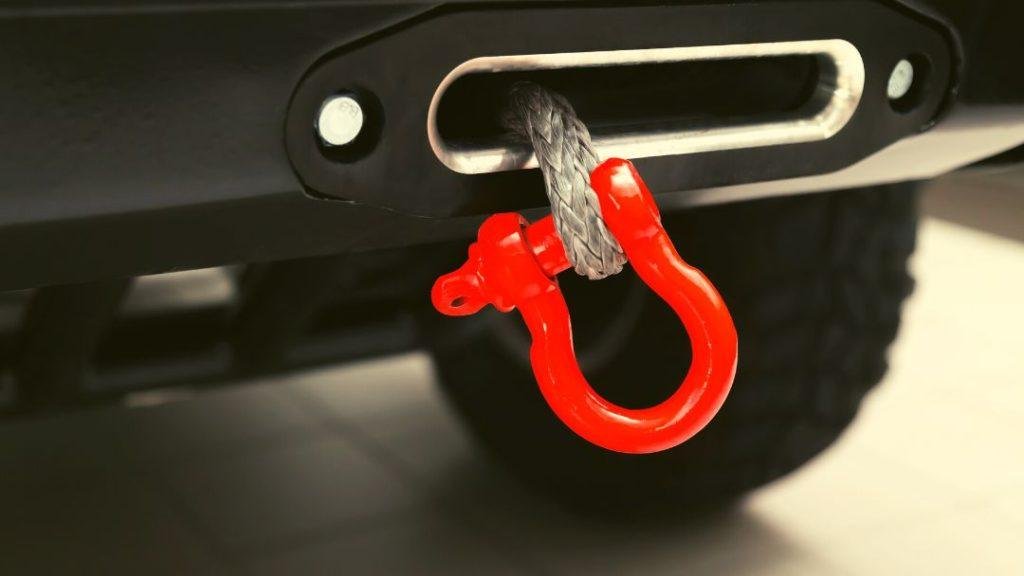
Preparing For A Winching Operation
Learn how to properly use a winch shackle for a successful winching operation. Mastering this essential technique ensures safety and efficiency in your towing and recovery endeavors.
Before you embark on a winching operation, it is crucial to take adequate preparatory measures to ensure a safe and successful outcome. This involves inspecting your winch shackle for any damage or wear, ensuring proper attachment points on your vehicle, and selecting the appropriate winch line for the job.
Let’s delve into each of these steps in detail:
Inspecting Your Winch Shackle For Any Damage Or Wear:
- Check for any visible signs of damage such as cracks, deformation, or rust.
- Verify that the pin and clevis are in proper working condition without any signs of wear or corrosion.
- Ensure the shackle has the necessary load rating and meets the required safety standards.
Ensuring Proper Attachment Points On Your Vehicle:
- Identify suitable attachment points on your vehicle that can handle the stress and force exerted during winching.
- Look for sturdy tow hooks, recovery points, or bumpers specifically designed for winching purposes.
- Make sure the attachment points are securely fastened and capable of distributing the load evenly.
Selecting The Appropriate Winch Line For The Job:
- Consider the weight and size of the vehicle you are winching and choose a winch line with a suitable load capacity.
- Determine the type of winch line material that best suits your needs (synthetic or steel) based on factors such as strength, flexibility, and weather resistance.
- Inspect the winch line for any signs of fraying, kinks, or cuts, and replace it if necessary.
By following these preparatory steps diligently, you can ensure that your winching operation proceeds smoothly. Remember, safety should always be your utmost priority. Now that you have inspected your winch shackle, identified proper attachment points, and selected the appropriate winch line, you are ready to proceed to the next stage of your winching process.
Proper Techniques For Using A Winch Shackle
Learn the proper techniques for using a winch shackle with these helpful guidelines. Follow these steps to ensure safe and effective use of your winch shackle.
Securely Attaching The Winch Shackle To The Anchor Point:
Attaching a winch shackle to the anchor point is a crucial step in ensuring a safe and successful winching operation. Here are some techniques to securely attach the winch shackle:
- Align the holes: Make sure the shackle’s holes line up with the anchor point’s attachment points.
- Insert the pin: Insert the pin through the aligned holes, ensuring it goes through both sides of the shackle and the anchor point.
- Secure the pin: Fasten the pin by either screwing it tight or securing it with a safety clip.
Connecting The Winch Line To The Winch Shackle:
Properly connecting the winch line to the winch shackle is vital for an effective winching process. Follow these steps to connect the winch line securely:
- Loop the winch line: Create a loop with the winch line by folding it over itself, ensuring that the loop is strong and tight.
- Thread the loop through the shackle’s opening: Pass the loop of the winch line through the opening of the winch shackle, allowing it to extend beyond the shackle.
- Secure the winch line loop: Thread the loose end of the winch line back through the loop, creating a secure connection.
Applying Tension Gradually And Evenly While Winching:
Applying tension gradually and evenly during the winching process is important for maintaining control and preventing accidents. Follow these techniques for smooth and safe winching:
- Start with low tension: Begin winching with low tension while assessing the load and the terrain.
- Apply tension slowly: Gradually increase the tension on the winch line, ensuring it is steady and controlled.
- Avoid jerking motions: Do not apply sudden or jerking movements to the winch line, as it can lead to damage or loss of control.
- Monitor the tension: Continuously monitor the tension on the winch line while winching, ensuring it remains within a safe range.
- Winch in short bursts: Rather than continuously winching, break the process into short bursts to prevent overheating and strain on the winch.
Remember, following these techniques for securely attaching the winch shackle, connecting the winch line, and applying tension gradually and evenly will result in a successful winching operation. Stay safe and make sure to always adhere to manufacturer’s guidelines.
Safety Considerations And Best Practices
When using a winch shackle, it is important to prioritize safety. Follow these best practices to ensure a secure and efficient operation.
When it comes to using a winch shackle, safety should always be your top priority. To ensure a smooth and accident-free operation, it is crucial to take certain precautions and follow best practices. Here are some important safety considerations you should keep in mind:
Wearing Appropriate Personal Protective Equipment (Ppe):
- Eye protection: Wearing safety goggles or glasses will shield your eyes from debris or flying particles during the winching process.
- Hand protection: Thick gloves are essential to protect your hands from cuts, abrasions, and potential pinch points.
- Body protection: It is advisable to wear long sleeves and pants to minimize the risk of injury from the winch line or other equipment.
- Footwear: Choose sturdy, non-slip boots that provide ankle support and protect your feet from potential hazards.
Maintaining A Safe Distance From The Winching Operation:
- Keep a safe distance: Always stand clear of the winching area, maintaining a distance of at least twice the length of the winch line. This will help prevent any accidents caused by unexpected line movement or equipment failure.
- Secure the area: Make sure no one is within the immediate vicinity of the winching operation to minimize the risk of injury to yourself or others.
- Communicate effectively: Establish clear signals or verbal communication with other people involved in the operation to ensure everyone is aware of the winching process and can respond accordingly.
Regularly Inspecting And Maintaining Your Winch Shackle:
- Visual inspection: Prior to each use, visually inspect the winch shackle for any visible signs of damage or wear. Look for cracks, deformations, or other indications that the shackle may be compromised.
- Check fasteners: Ensure all bolts and pins are securely fastened and tightened before each use.
- Lubrication: Apply a suitable lubricant to the shackle’s moving parts to keep it functioning smoothly and prevent rust or corrosion.
Remember, adhering to these safety considerations and best practices will not only protect your well-being but also contribute to the efficient and effective use of your winch shackle. By prioritizing safety, you can ensure a successful winching operation every time.
Troubleshooting Common Winching Issues
Winching can come with its share of issues, but troubleshooting them is easier than you think. One common problem is knowing how to properly use a winch shackle. Keep reading to find out the best techniques for using a winch shackle effectively.
Dealing With Stuck Winch Shackles
- Sometimes, winch shackles can get stuck, making it difficult to release the winch line or connect it to an anchor point. Here are some troubleshooting tips to help you deal with stuck winch shackles:
- Apply lubrication: If the winch shackle is stuck due to rust or corrosion, try applying a lubricant like wd-40 or a light machine oil. This can help loosen up the shackle and make it easier to manipulate.
- Use heat: In cases where the winch shackle is stuck due to extreme cold or freezing conditions, applying heat can help. Use a heat gun or a hairdryer to warm up the shackle, but be cautious not to overheat it or cause damage.
- Tap and wiggle: Give the stuck shackle a gentle tap with a hammer or a mallet to dislodge any debris or rust. Once loosened, try wiggling the shackle back and forth to free it up.
- Apply force: If none of the above methods work, you may need to apply more force to loosen the stuck shackle. Use pliers or a wrench to grip the shackle and apply pressure while twisting or pulling. Be careful not to damage the shackle or the winch line in the process.
Preventing Winch Line Slippage During Operation
- Winch line slippage can be a frustrating issue that affects the effectiveness of your winching operation. Here are some tips to prevent winch line slippage:
- Properly spool the winch line: Make sure the winch line is spooled evenly onto the winch drum. Uneven spooling can lead to line slippage. Avoid overlapping or underlapping the line during spooling to maintain a smooth and secure grip.
- Use a winch line damper: A winch line damper can help prevent winch line slippage by adding weight and stability to the line during operation. The additional weight reduces the likelihood of the line shifting or slipping off the drum.
- Maintain proper tension: Keep the winch line tensioned throughout the entire operation. Loose or slack lines are more prone to slippage. Monitor the tension and adjust as needed to ensure a secure grip.
- Use appropriate anchor points: Choosing the right anchor points is crucial to prevent winch line slippage. Ensure the anchor points are strong, secure, and capable of withstanding the pulling force of the winch. Avoid using weak or unstable anchor points that may lead to slippage.
- Inspect the winch line regularly: Regularly inspect the winch line for signs of wear, fraying, or damage. Replace any worn-out or damaged sections immediately to maintain a secure grip and prevent slippage.
Recovering From Winching Mishaps And Incidents
- While winching can be a powerful tool for recovery, mishaps and incidents can still occur. Here are some tips to help you recover from winching mishaps:
- Assess the situation: Take a moment to assess the situation and analyze what went wrong. Identify any potential risks or hazards before taking further action.
- Release tension: If the winching operation has resulted in a vehicle tipping or becoming unstable, release the tension on the winch line immediately. This will relieve the stress on the vehicle and prevent further damage or accidents.
- Call for assistance if needed: If the mishap or incident is beyond your capabilities to resolve safely, don’t hesitate to call for professional assistance. It’s better to seek help rather than exacerbate the situation and put yourself or others at risk.
- Reassess anchor points: After a mishap, it’s essential to reassess the anchor points and ensure they are secure and capable of handling the recovery operation. If necessary, relocate or reinforce the anchor points to prevent further incidents.
- Inspect equipment: Thoroughly inspect the winch, winch line, shackles, and other equipment involved in the mishap. Look for any damage or signs of wear that may have contributed to the incident. Replace or repair damaged equipment before proceeding with any further winching operations.
Remember, proper winching techniques and precautions are vital to ensure safe and effective recoveries. Always prioritize safety and consult the manufacturer’s instructions and guidelines for your specific winch and equipment.
Taking Your Off-Road Adventures To The Next Level
Discover new ways to enhance your off-road adventures with the proper use of a winch shackle. Learn how to take your outdoor experiences to the next level with this essential tool.
Are you an off-road enthusiast looking to up your game? Adding a winch shackle to your off-road arsenal could be the game-changer you’ve been seeking. Not only will it increase the functionality of your winching equipment, but it will also open up possibilities for more advanced winching techniques.
In this section, we’ll explore how to take your off-road adventures to the next level by mastering advanced winching techniques, upgrading your winch shackle equipment, and joining off-road communities for knowledge sharing and experiences.
Exploring Advanced Winching Techniques
Expanding your knowledge of winching techniques can greatly enhance your off-road experiences. Here are some advanced techniques to consider:
- Anchoring methods: Learn different ways to anchor your winch, including using natural elements like trees or rocks, and utilizing anchor points on your vehicle or accessories.
- Multi-directional pulls: Discover the benefits of pulling in multiple directions to navigate challenging terrain or extract your vehicle from tricky situations.
- Dampening the line: Understand how to control the tension on your winch line by utilizing dampeners or blankets, reducing the risk of line breakage and ensuring a safer operation.
- Double line pulls: Explore the advantages of using multiple lines to increase pulling power and distribute the load evenly.
Upgrading Your Winch Shackle Equipment
While a winch shackle is a vital component of your off-road gear, not all shackles are created equal. Consider upgrading your equipment to ensure optimal performance and safety. Here are some key factors to consider:
- Material selection: Opt for shackles made from strong and durable materials like stainless steel or high-grade alloy, ensuring longevity and reliability.
- Load rating: Check the load rating of your shackle and ensure it can handle the weight and force requirements of your off-road adventures.
- Safety features: Look for shackles with safety pins, locking mechanisms, or quick-release mechanisms to ensure secure connections and ease of use.
- Size and design: Choose a shackle that fits your vehicle’s winch system and any recovery accessories you may use, ensuring compatibility and efficient operation.
Joining Off-Road Communities For Knowledge Sharing And Experiences
Being part of an off-road community can provide you with a wealth of information, tips, and experiences that can take your off-road adventures to new heights. Here’s why joining these communities is beneficial:
- Knowledge sharing: Engage with fellow off-road enthusiasts to exchange insights, techniques, and recommendations on winching and other off-road challenges.
- Networking opportunities: Connect with experienced off-roaders who can offer guidance, share resources, and even accompany you on exciting adventures.
- Group activities: Participate in group meetups, off-road events, or organized trail rides to surround yourself with like-minded individuals and gain practical experience together.
- Safety awareness: Stay up to date with the latest safety practices and regulations in off-roading, ensuring you enjoy your adventures while minimizing risks.
By familiarizing yourself with advanced winching techniques, upgrading your winch shackle equipment, and joining off-road communities, you’ll be well-equipped to elevate your off-road adventures to the next level. It’s time to unleash the full potential of your off-road vehicle and conquer new challenges with confidence.
Get ready to embrace the thrill of off-roading like never before!
Frequently Asked Questions For How To Use A Winch Shackle
How Do You Use A Rope Shackle?
To use a rope shackle, first, loop the rope through the shackle’s eye. Then, tighten the loop securely. Next, slide the shackle pin through the loops of the rope ends. Finally, ensure the pin is locked into place by tightening its nut.
What Is The Difference Between A Soft Shackle And A D Ring?
A soft shackle and a d ring are both types of hardware used in rigging and towing operations. The main difference lies in their construction and how they are used. A soft shackle is made from strong synthetic materials like dyneema or spectra, while a d ring is typically made of metal.
Soft shackles are flexible and lightweight, making them easy to handle and store. They are also non-metallic, which makes them safe to use in situations where metal might cause damage, such as marine applications. D rings, on the other hand, are more durable and can support heavier loads.
They are commonly used in the construction industry and are known for their strength and reliability. In summary, soft shackles offer flexibility and are ideal for lightweight applications, while d rings are stronger and better suited for heavy-duty tasks.
How Safe Are Soft Shackles?
Soft shackles are safe and reliable alternatives to traditional metal shackles. Made from high-strength synthetic fibers, such as dyneema or spectra, they offer numerous advantages. Firstly, their lightweight construction makes them easier to handle and transport. Secondly, they do not rust or corrode, enhancing their durability and longevity.
Additionally, their soft structure eliminates the risk of damage to surfaces, equipment, or personnel. Soft shackles are designed with strong load-bearing capacities, ensuring optimal performance in a wide range of applications. Despite their strength, soft shackles are not recommended for critical or life-saving situations.
It is important to follow manufacturer guidelines and conduct regular inspections to ensure their continued safety. With proper use and maintenance, soft shackles provide a secure and efficient solution for various lifting and rigging needs.
How Do Soft Recovery Shackles Work?
Soft recovery shackles are designed to provide a safer and more efficient way to recover stuck vehicles. These shackles are made from strong and durable materials, such as synthetic fibers or nylon, which allow them to stretch and absorb energy during the recovery process.
When a vehicle is stuck, the shackle is attached to a recovery point on the vehicle, and the other end is attached to an anchor point. As the recovery vehicle pulls, the soft shackle stretches and generates kinetic energy, which helps to reduce the shock load on both vehicles.
This elasticity also allows for a smoother and more controlled recovery, minimizing the risk of sudden jolts or damage. Soft recovery shackles are lightweight and easy to handle, making them a popular choice among off-road enthusiasts and professional recovery operators.
Conclusion
To conclude, using a winch shackle is an essential skill that every off-roader should master. By following the proper steps and guidelines, you can ensure a safe and successful recovery process. Remember to select a sturdy winch shackle that is suitable for your vehicle’s weight and towing capacity.
Take your time to familiarize yourself with the different types of shackles available and choose one that meets your specific needs. Always inspect the shackle before each use to ensure it is in good condition and free from any damage.
Practice using the winch shackle in a controlled environment before attempting a real recovery situation. And most importantly, prioritize safety at all times by using appropriate protective gear and following your vehicle manufacturer’s guidelines. With these tips in mind, you’ll be well-prepared to tackle any off-road recovery situation with confidence and ease.

